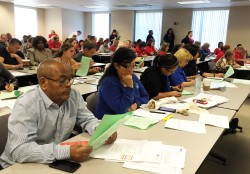UNAC/UHCP Members Testify at Cal/OSHA Hearing on Workplace Violence in Hospitals
April 2015
 On April 1, UNAC/UHCP members testified at a Cal/OSHA hearing on draft workplace violence prevention regulations currently being crafted. Workplace violence is a critical issue for nurses and other health care workers in the hospital, and the regulations developed here in California could impact how the entire country addresses this pervasive problem.
On April 1, UNAC/UHCP members testified at a Cal/OSHA hearing on draft workplace violence prevention regulations currently being crafted. Workplace violence is a critical issue for nurses and other health care workers in the hospital, and the regulations developed here in California could impact how the entire country addresses this pervasive problem.
UNAC/UHCP members provided crucial testimony as the draft regulations are taking shape, sharing stories of how on-the-job violence has impacted them. These stories will help strengthen the coming regulations for optimal violence prevention.
UNAC/UHCP RN Rosa Carcamo testified about the need to broaden language in regulations that defined weapons. "A chair and a pen are not perceived as weapons or instruments, conventionally, designed to inflict death or serious injury, but I, personally, have been attacked at my hospital with a chair. My co-worker was placed in a choke hold while a patient held a pen to her jugular." Carcamo went on to recommend the definition of "weapon" be broadened to include: fashioned, improvised, and make-shift weapons.
Susanna Adame, a UNAC/UHCP RN from a San Fernando Valley hospital, spoke at the hearing about reportable workplace violence incidents. She suggested that threats be added to reportable incidents, reporting, "I asked an uncooperative patient to vacate a bed because the personnel transporting her to a psychiatric facility had arrived. She was combative. I perceived a threat and so did others. She lunged at me with her fists attempting to injure me. Luckily, I was not alone. The security guard anticipated the attack and absorbed the brunt of it being thrown against a wall by her brute force."
Marilen Castanon, RN, added to Adame's testimony with her own, suggesting workplace bullying be added to the list of reportable incidents. "Peer-to-peer or management-to-subordinate bullying is a common occurrence in the workplace. Managers threaten nurses for reporting incidents and take retaliatory measures such as assigning them to a night shift; at times being verbally abusive regardless of whether a patient is present. Bullying can be a risk to patient safety and patient care, if not reported," stated Castanon.
Kef Workie, RN, a UNAC/UHCP member from a Los Angeles hospital, addressed Cal/OSHA to talk about working in an isolated condition. Sharing his story, he said, "I was attacked by a patient with a chair while alone in an occupational therapy room. I ran towards to nurses station which was locked and was unable to flee. The patient punched me in the back repeatedly. Implementing a 'safe number system (SNS)' or safe staffing ratios would largely reduce the number of workplace violence incidents sustained by many health care workers. We need a better system."
Liz Hawkins, RN, added to Workie's testimony, telling her own story and saying, "Conditions where you are short-staffed place health care workers in danger. There should always be a 'partner' like police officers have when they go on patrol. Our risk of attack is second only to that of police officers. We need to have enforceable staffing ratios that ensure our safety."
To support the efforts of UNAC/UHCP and these incredible member representatives, please sign our petition urging Cal/OSHA to take immediate steps to address workplace violence: https://www.change.org/p/california-division-of-occupational-safety-and-health-help-stop-violent-attacks-on-health-care-workers
